







Cambodia was incredible. I loved the family-like bond that formed while traveling with others. Floating down the river and seeing villagers wave and greet us was a special experience.
It was even more impressive to see the floating houses of Cambodian locals, a unique way of life that I had never witnessed before. This was an incredible service trip I would do 10,000 times.
Teaching English to local children was both challenging and rewarding. They learned quickly, and it was fulfilling to see their progress.
Here are some key facts about Cambodia:
| Key Facts About Cambodia | Details |
| Population | 17,818,838 |
| Official Language | Khmer |
| Capital | Phnom Penh |
| Currency | Riel |
| Main Religion | Theravada Buddhism (~97%) |
| National Dish | Amok, a curry dish with fish and coconut milk |
I’d like to share some fun facts about Cambodia that I learned during my trip to Cambodia with Rustic Pathways.
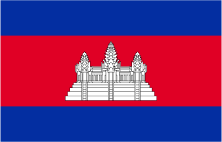
In 802 AD, Jayavarman II united the Khmer princes and became the founder of the Khmer Empire, the predecessor to Cambodia.
Cambodia’s history gets dark. The Khmer Republic was a US-backed military dictatorship aligned with US-backed South Vietnam that ruled in Cambodia from 1970 to 1975, following a coup that overthrew Norodom Sihanouk and abolished the monarchy.
The Khmer Republic fell in 1975 when the Khmer Rouge captured Phnom Penh. The Khmer Rouge briefly restored the Kingdom of Cambodia before renaming it Democratic Kampuchea in 1976.
Between 1975 and 1979, Cambodia was ruled by the Khmer Rouge regime and its leader Pol Pot. During this civil war period, between 1.5 and 2 million people were murdered – many of whom died in the Killing Fields. This mass decimation of the Cambodian population left a lasting mark on the country.
The ruling Cambodian People’s Party (CPP) has ruled Cambodia since 1979. Founded in 1951 as the Kampuchean People’s Revolutionary Party (KPRP), it allied with Vietnam and the Soviet Union during the Cold War against Pol Pot’s pro-Chinese Communist Party. After toppling the Khmer Rouge, it became the ruling party of the People’s Republic of Kampuchea, later renamed the State of Cambodia.
The Cambodian government is a constitutional monarchy, with King Norodom Sihamoni as the current head of state. The Royal Council of the Throne is a nine-member council in Cambodia responsible for selecting the Cambodian monarch. The Council elects the king for life from among male descendants of the King. Voting is conducted through a secret ballot among the nine members.
The Cambodian parliament consists of two houses: the National Assembly and the Senate. Cambodia has a multi-party political system, though the ruling Cambodian People’s Party (CPP) has held power for years. The current Prime Minister of Cambodia is Hun Manet. The previous prime minister Hun Sen served as Prime Minister of Cambodia from 1985 to 2023. Hun Sen remains in the Cambodian government as Senate President.
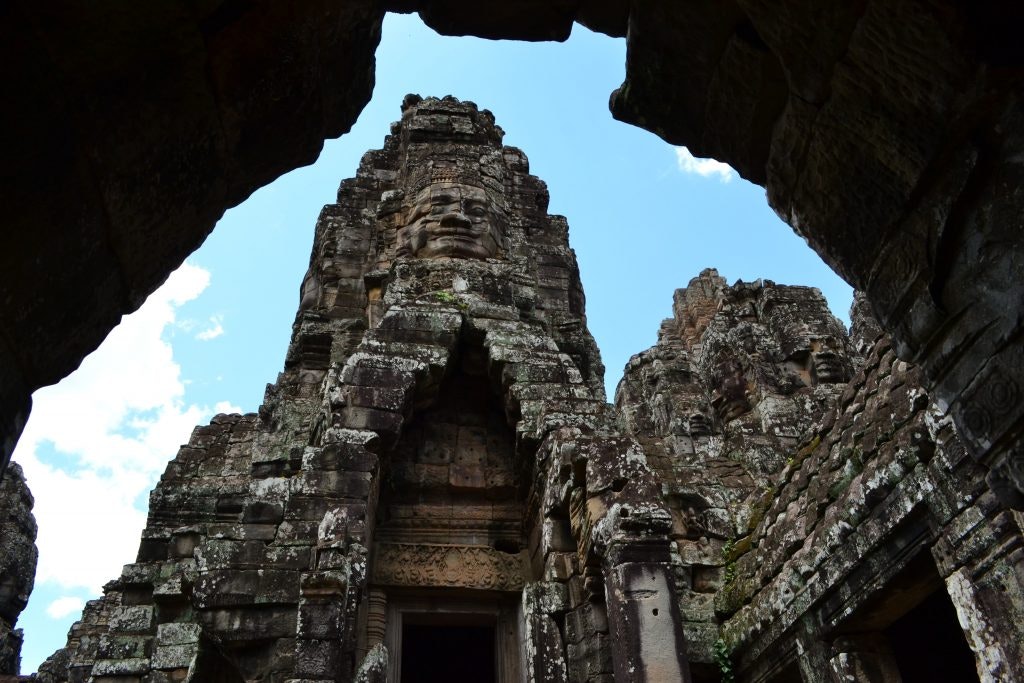
The Bayon temple was built in the late 12th century as the state temple of King Jayavarman VII
Cambodia’s climate is hot and tropical, with a wet season from May to October and a dry season from November to April.

The tropical weather comes with year around fresh produce. Here is an array of fruits, veggies, grains, and nuts at the market in Battambang.
Cambodia is home to Southeast Asia’s largest freshwater lake, Tonle Sap Lake. The lake’s size changes from season to season, ranging from an area of 965 mi² to 6,178 mi² (2,500km² to 16,000km²). The flow of the Tonle Sap River changes direction twice a year.
The Mekong River flows through Cambodia and is a vital source of water and transportation. In fact, the Cambodian traditional house is typically made of wood and raised on stilts to protect against flooding. The Irrawaddy dolphin, an endangered species, can be found in the Mekong River in Cambodia.
The Cardamom Mountains in Southwestern Cambodia are a biodiversity hotspot, with many rare and endangered species.

Students on a private boat during the Come With Nothing, the Mekong Expedition.
Cambodia has a population of over 16 million people. The official language of Cambodia is Khmer and Buddhism is the main religion, with 97% of the Cambodian population identifying as Buddhist. The capital city of Cambodia is Phnom Penh.
80% of Cambodian people are literate. The average life expectancy is approximately 69 years. Cambodia’s population is young; most of its people are under 20 years of age.
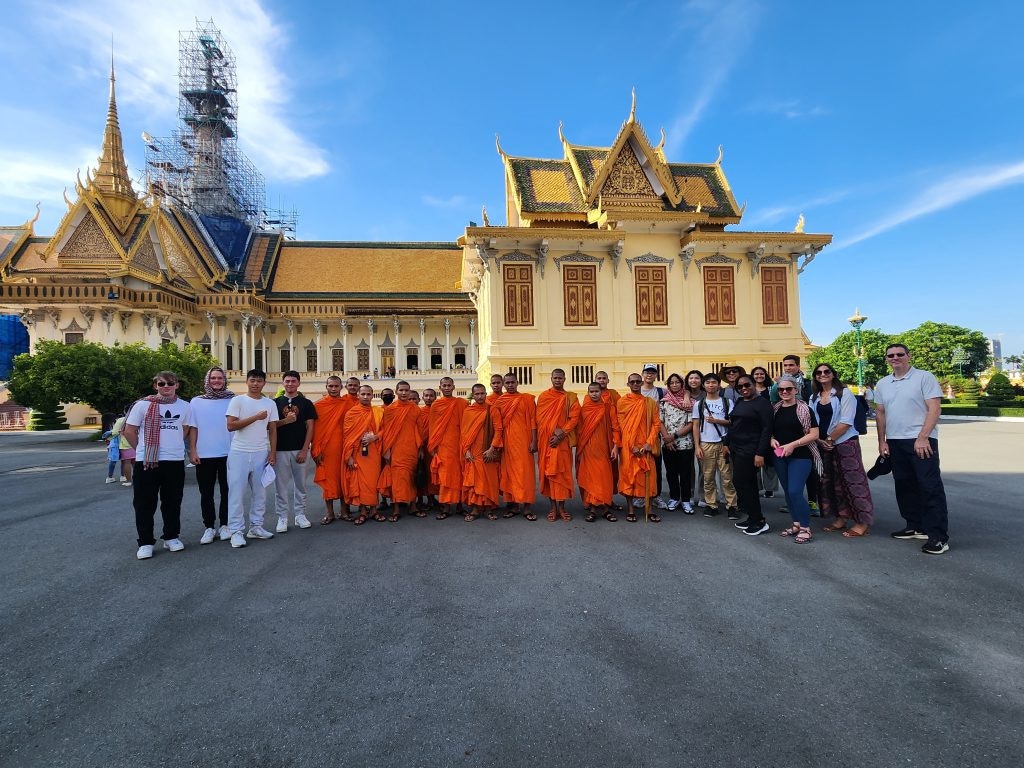
A school group visiting a Buddhist temple in Cambodia.
Cambodians do not celebrate birthdays and many older people do not know their age. Most celebrate growing older along the cycle of the lunar new year.
Cambodian cuisine is known for its use of fresh herbs, spices, and fish, with dishes like fish amok and kuy teav (noodle soup) being popular. Amok is Cambodia’s national dish, a curry that is steam-cooked in banana leaves. Varieties of amok include fish, chicken, tofu and more.
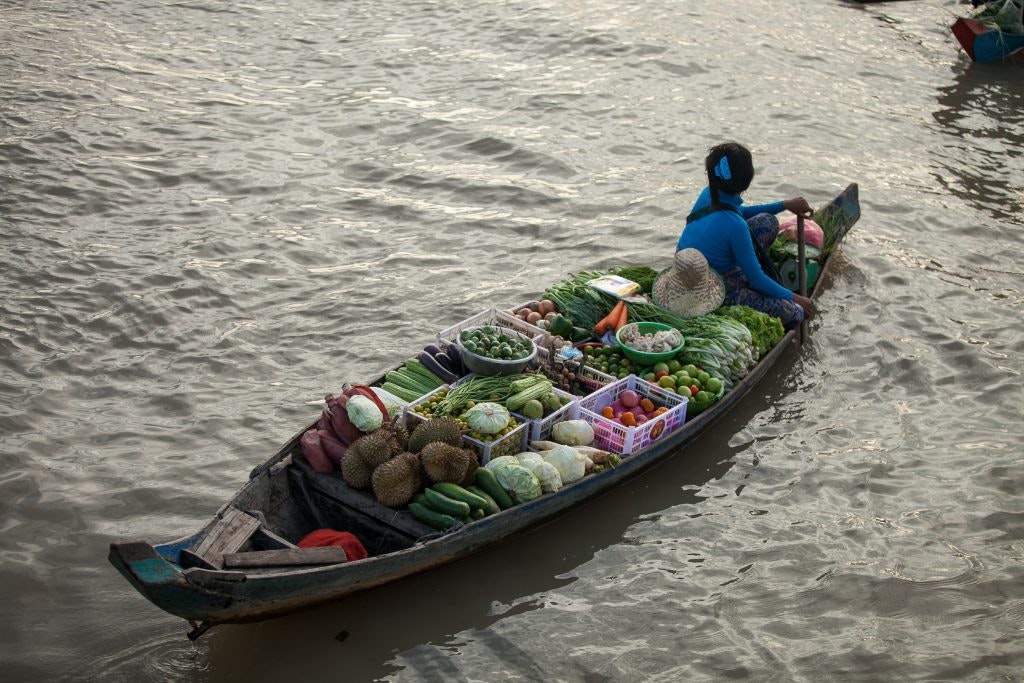
Fresh produce is plentiful in Cambodia. This woman sells fruits and vegetables from her boat in the Prek Toal floating village.
The Cambodian flag is red and blue in color and features a depiction of Angkor Wat. Contrary to popular belief, the Cambodian flag is not the only flag in the world that features a building. The Cambodian flag is unique as it prominently features Angkor Wat.
The other countries with buildings on their flags are Afghanistan, Bolivia, Portugal, San Marino, and Spain. However, Cambodia is the only country where the building is a main feature rather than a border element.
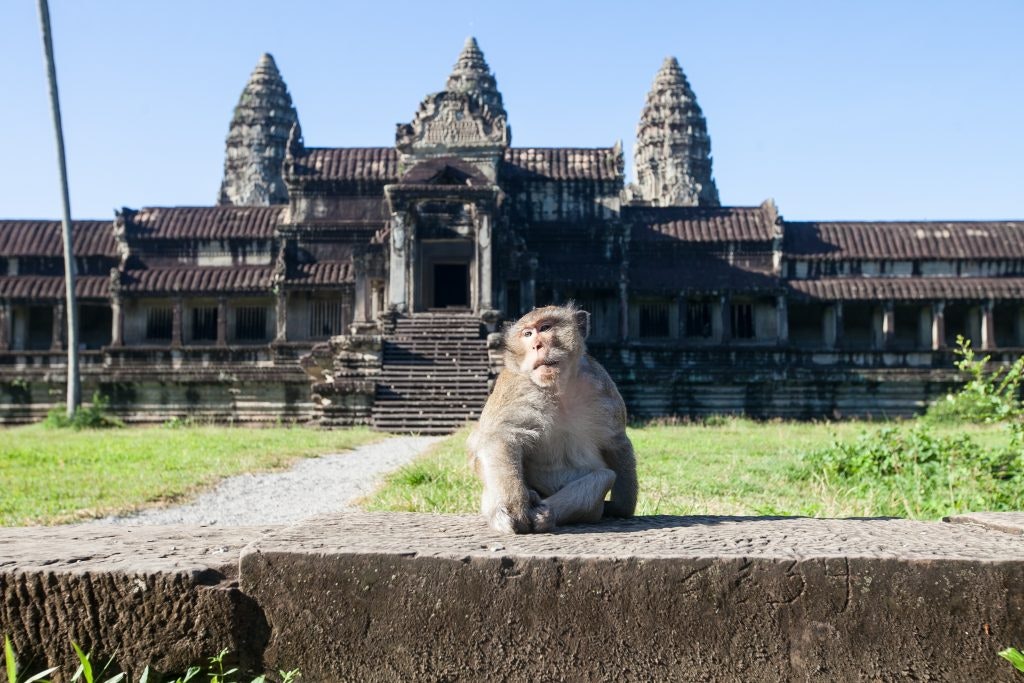
Angkor Wat is amongst the largest religious monuments in the world.
The temples of Angkor were built by the Khmer civilization between 802 AD and 1220 AD. Angkor Wat is the largest, best-preserved, and most religiously significant of all Angkor temples. Angkor Wat is double the size of the world’s second-largest religious complex, Sri Ranganathasvamy, a Hindu temple in India.
The structure is adorned with intricate stone carvings and bas reliefs narrating stories from Hindu mythology, including the famous Churning of the Ocean of Milk. The temple has the longest continuous bas relief in the world and the westward orientation of Angkor Wat is likely due to it being a funerary temple or mausoleum.
Angkor Wat was featured in the movie “Tomb Raider,” and the production house was charged $10,000 per day for filming. Angkor Wat has been a UNESCO World Heritage Site since 1992.
Almost half of international tourists to Cambodia visit Angkor Wat with 2 million visiting. The temple is undergoing restoration, funded largely by foreign aid. Only 28% of ticket revenue goes to restoration.
Cambodia has one of the fastest-growing economies in Asia, with an average annual growth rate of 7% over the past decade. The top three sectors are agriculture, textiles and tourism.
Agriculture is a major part of Cambodia’s economy, with wet rice cultivation being the primary crop. The main rice-growing regions are around the Mekong River and Tonle Sap Lake.
The textile industry employs over 600,000 people. Tourism is a key industry in Cambodia, attracting millions of visitors each year.
Read Frequently Asked Questions About Traveling to Cambodia
Sport is popular in Cambodia, though the country has never won an Olympic medal. Cambodia has a number of sports that compete with soccer (football) for popularity including:
50% of all voice message traffic on Facebook Messenger comes from Cambodia, according to documents released by whistleblower Frances Haugen. Keyboards on modern computers weren’t designed for Khmer script, the writing system of the Khmer language, so Cambodia’s population prefers to use voice memos.
Khmer script is written from left to right, with words usually run together without spaces. The script was adapted from the Pallava script of southern India and Southeast Asia. The oldest known Khmer inscription dates back to 611 AD.
The norry, or bamboo train, is a form of transportation in Cambodia, particularly in the Battambang region. After the Khmer Rouge government was overthrown, locals used leftover scrap from tanks and vehicles to repair the tracks. They built small bamboo ‘trains’ to transport goods and passengers.
Want to visit Cambodia and discover more that the country has to offer? Schedule a call to learn more about available student travel and school group trips to Cambodia.
💡 Want more trivia?
Browse all Fun Facts articles.